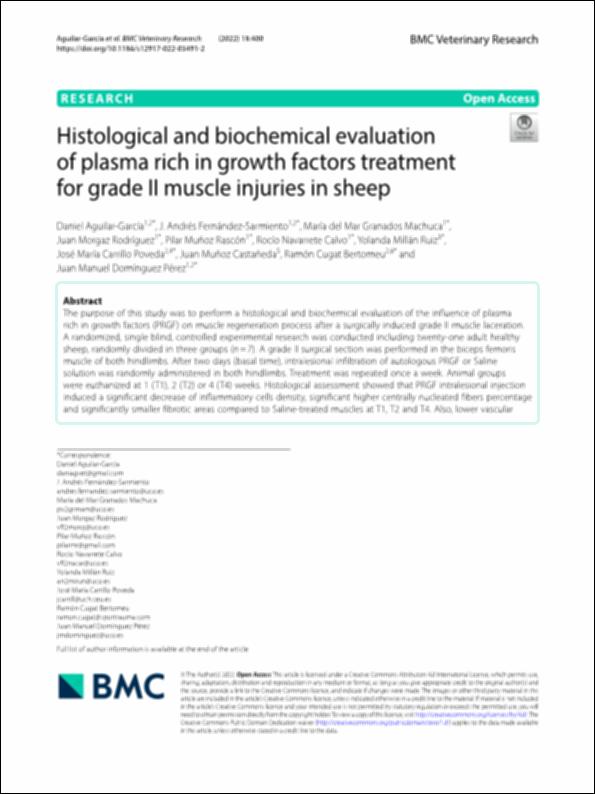Por favor, use este identificador para citar o enlazar este ítem:
http://hdl.handle.net/10637/14373Histological and biochemical evaluation of plasma rich in growth factors treatment for grade II muscle injuries in sheep
| Título : | Histological and biochemical evaluation of plasma rich in growth factors treatment for grade II muscle injuries in sheep |
| Autor : | Aguilar García, Daniel Fernández Sarmiento, José Andrés Granados Machuca, María del Mar Morgaz Rodríguez, Juan Muñoz Rascón, Pilar Navarrete Calvo, Rocío Carrillo Poveda, José María. |
| Materias: | Muscles - Wounds and injuries - Treatment.; Músculos - Heridas y lesiones - Tratamiento.; Blood plasma - Therapeutic use.; Growth factors - Therapeutic use.; Plasma sanguíneo - Uso terapéutico.; Crecimiento - Factores - Uso terapéutico. |
| Editorial : | Springer Nature |
| Citación : | Aguilar-García, D., Fernández-Sarmiento, J. A., Del Mar Granados Machuca, M., Rodríguez, J. M., Rascón, P. M., Calvo, R. N., Ruiz, Y. M., Poveda, J. M. C., Castañeda, J. M., Bertomeu, R. C., & Domínguez Pérez, J. M. (2022). Histological and biochemical evaluation of plasma rich in growth factors treatment for grade II muscle injuries in sheep. BMC Veterinary Research, vol. 18, i. 1 (12 nov.), art. 400. DOI: https://doi.org/10.1186/s12917-022-03491-2 |
| Resumen : | The purpose of this study was to perform a histological and biochemical evaluation of the influence of plasma rich in growth factors (PRGF) on muscle regeneration process after a surgically induced grade II muscle laceration. A randomized, single blind, controlled experimental research was conducted including twenty-one adult healthy sheep, randomly divided in three groups (n = 7). A grade II surgical section was performed in the biceps femoris muscle of both hindlimbs. After two days (basal time), intralesional infiltration of autologous PRGF or Saline solution was randomly administered in both hindlimbs. Treatment was repeated once a week. Animal groups were euthanized at 1 (T1), 2 (T2) or 4 (T4) weeks. Histological assessment showed that PRGF intralesional injection induced a significant decrease of inflammatory cells density, significant higher centrally nucleated fibers percentage and significantly smaller fibrotic areas compared to Saline-treated muscles at T1, T2 and T4. Also, lower vascular density, with lower capillaries cross-sectional area, in PRGF group compared to Saline was observed. Biochemical analysis revealed a significant higher expression level of MYOD1, MYF5 and MYOG genes in PRGF groups at T1 compared to Saline treated muscles. At ultrastructural level, PRGF groups presented scarce edema and loss of connective tissue structure, as well as higher mitochondrial density adequately associated to the sarcomere unit in contrast to the Saline group. In conclusion, histological, biochemical, and ultrastructural results showed that PRGF treatment improved muscle regeneration process leading to more mature histological aspect in newly formed muscle tissue after a surgically induced grade II muscle injury. |
| Descripción : | Este artículo se encuentra disponible en la siguiente URL: https://bmcvetres.biomedcentral.com/articles/10.1186/s12917-022-03491-2 En este artículo de investigación también participan: Yolanda Millán Ruiz, Juan Muñoz Castañeda, Ramón Cugat Bertomeu y Juan Manuel Domínguez Pérez. |
| URI : | http://hdl.handle.net/10637/14373 |
| Derechos: | http://creativecommons.org/licenses/by/4.0/deed.es |
| ISSN : | 1746-6148 (Electrónico) |
| Idioma: | es |
| Fecha de publicación : | 12-nov-2022 |
| Centro : | Universidad Cardenal Herrera-CEU |
| Aparece en las colecciones: | Dpto. Medicina y Cirugía Animal |
Los ítems de DSpace están protegidos por copyright, con todos los derechos reservados, a menos que se indique lo contrario.


